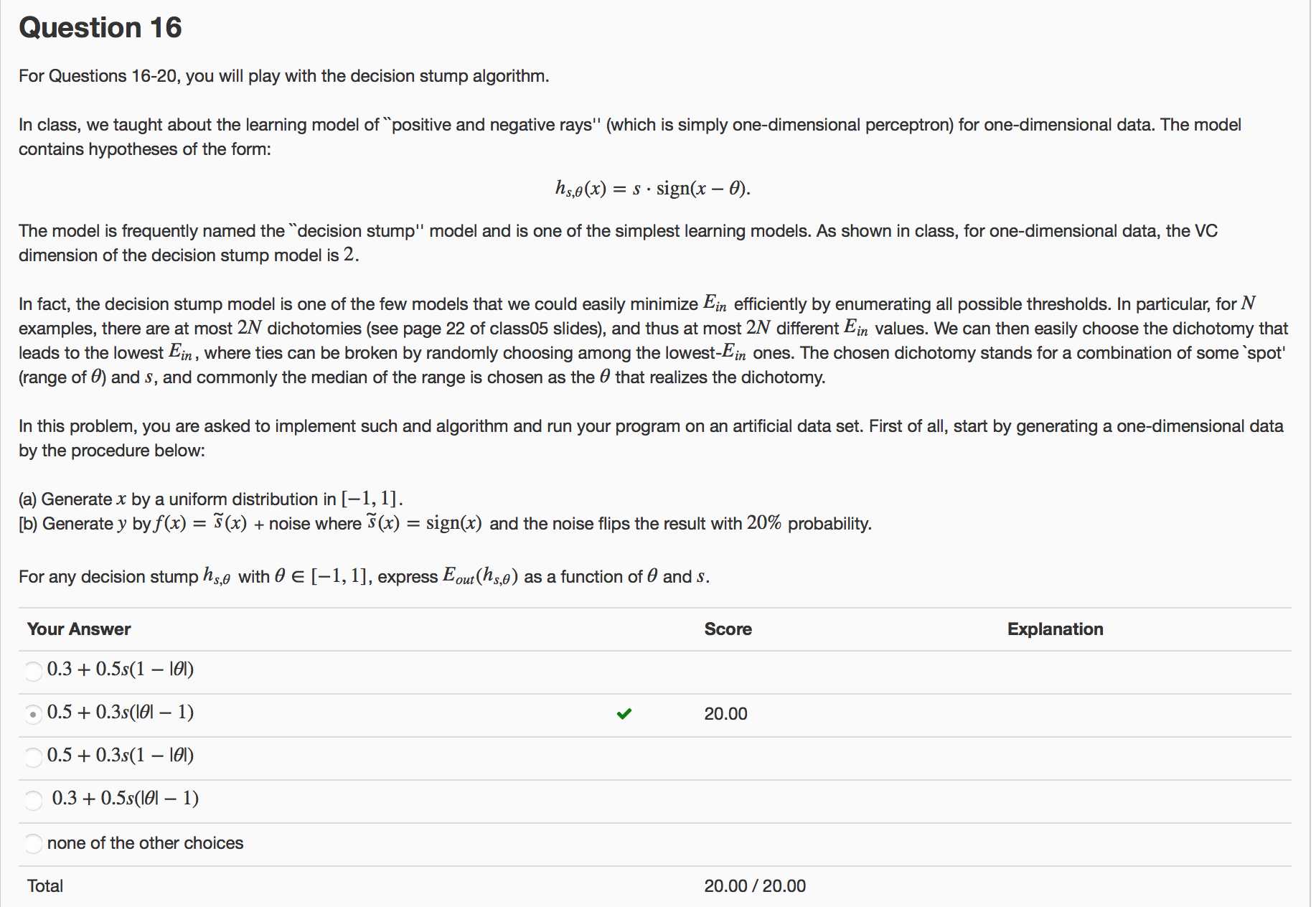标签:
作业一被bubuko抓取了,要是能注明转载就更好了(http://bubuko.com/infodetail-916604.html)
作业二关注的题目是需要coding的Q16~Q20
Q16理解了一段时间,题目阐述的不够详细。理解了题意之后,发现其实很简单。
理解问题的关键是题目中给的‘s‘是啥意思:
(1)如果s=1,则意味着x>theta y预测为1,x<theta y预测为-1;
(2)如果s=2,则以为着x<theta y预测为1,x<theta y预测为1
想明白这个事情之后,直接分theta大于0,小于0讨论,s=1 or s=-1把几种情况分别写一下,再合一起就得到答案了。

Q17~Q18题目的代码如下
#encoding=utf8 import sys import numpy as np import math from random import * # generate input data with 20% flipping noise def generate_input_data(time_seed): np.random.seed(time_seed) raw_X = np.sort(np.random.uniform(-1,1,20)) noised_y = np.sign(raw_X)*np.where(np.random.random(raw_X.shape[0])<0.2,-1,1) return raw_X, noised_y def calculate_Ein(x,y): # calculate median of interval & negative infinite & positive infinite thetas = np.array( [float("-inf")]+[ (x[i]+x[i+1])/2 for i in range(0, x.shape[0]-1) ]+[float("inf")] ) Ein = x.shape[0] sign = 1 target_theta = 0.0 # positive and negative rays for theta in thetas: y_positive = np.where(x>theta,1,-1) y_negative = np.where(x<theta,1,-1) error_positive = sum(y_positive!=y) error_negative = sum(y_negative!=y) if error_positive>error_negative: if Ein>error_negative: Ein = error_negative sign = -1 target_theta = theta else: if Ein>error_positive: Ein = error_positive sign = 1 target_theta = theta # two corner cases if target_theta==float("inf"): target_theta = 1.0 if target_theta==float("-inf"): target_theta = -1.0 return Ein, target_theta, sign if __name__ == ‘__main__‘: T = 1000 total_Ein = 0 sum_Eout = 0 for i in range(0,T): x,y = generate_input_data(i) curr_Ein, theta, sign = calculate_Ein(x,y) total_Ein = total_Ein + curr_Ein sum_Eout = sum_Eout + 0.5+0.3*sign*(abs(theta)-1) print (total_Ein*1.0) / (T*20) print (sum_Eout*1.0) / T
迭代次数上偷懒了,用的1000次代替5000次的结果。
coding算法思路没有什么复杂的,主要在于学习了python numpy的一些操作(如numpy.where, numpy.sign, numpy.sort)。
具体的参考学习了讨论区的(https://class.coursera.org/ntumlone-002/forum/thread?thread_id=191)。
Q19~Q20的代码如下,
#encoding=utf8 import sys import numpy as np import math from random import * def read_input_data(path): x = [] y = [] for line in open(path).readlines(): items = line.strip().split(‘ ‘) tmp_x = [] for i in range(0,len(items)-1): tmp_x.append(float(items[i])) x.append(tmp_x) y.append(float(items[-1])) return np.array(x),np.array(y) def calculate_Ein(x,y): # calculate median of interval & negative infinite & positive infinite thetas = np.array( [float("-inf")]+[ ( x[i]+x[i+1] )/2 for i in range(0, x.shape[0]-1) ]+[float("inf")] ) Ein = x.shape[0] sign = 1 target_theta = 0.0 # positive and negative rays for theta in thetas: y_positive = np.where(x>theta,1,-1) y_negative = np.where(x<theta,1,-1) error_positive = sum(y_positive!=y) error_negative = sum(y_negative!=y) if error_positive>error_negative: if Ein>error_negative: Ein = error_negative sign = -1 target_theta = theta else: if Ein>error_positive: Ein = error_positive sign = 1 target_theta = theta return Ein, target_theta, sign if __name__ == ‘__main__‘: x,y = read_input_data("train.dat") # record optimal descision stump parameters Ein = x.shape[0] theta = 0 sign = 1 index = 0 # multi decision stump optimal process for i in range(0,x.shape[1]): input_x = x[:,i] input_data = np.transpose(np.array([input_x,y])) input_data = input_data[np.argsort(input_data[:,0])] curr_Ein,curr_theta,curr_sign = calculate_Ein(input_data[:,0],input_data[:,1]) if Ein>curr_Ein: Ein = curr_Ein theta = curr_theta sign = curr_sign index = i print (Ein*1.0)/x.shape[0] # test process test_x,test_y = read_input_data("test.dat") test_x = test_x[:,index] predict_y = np.array([]) if sign==1: predict_y = np.where(test_x>theta,1.0,-1.0) else: predict_y = np.where(test_x<theta,1.0,-1.0) Eout = sum(predict_y!=test_y) print (Eout*1.0)/test_x.shape[0]
这个代码基本复用了calculate_Ein这个函数,只是对corner cases稍作修改。
其中有个地方遇到了些麻烦,就是要对输入的(xi,y)按照xi进行排序。
之前用过lambda表达式,在这里学习了一种numpy.argsort()的方法(http://blog.csdn.net/maoersong/article/details/21875705)
根据数组的某一个dimension,对矩阵按行进行重新排序(原理是返回排序后的的航标,重新生成一个矩阵)
标签:
原文地址:http://www.cnblogs.com/xbf9xbf/p/4595990.html